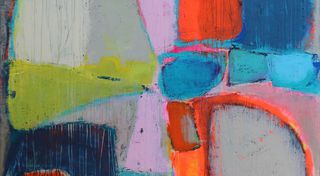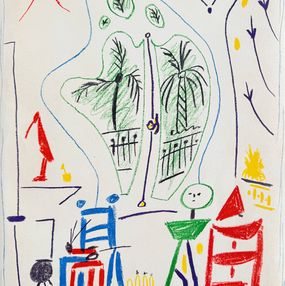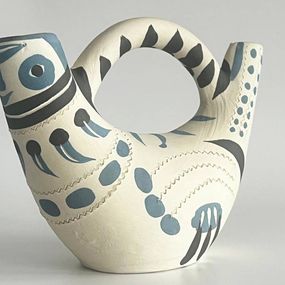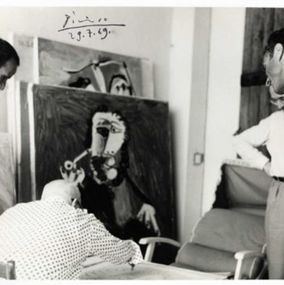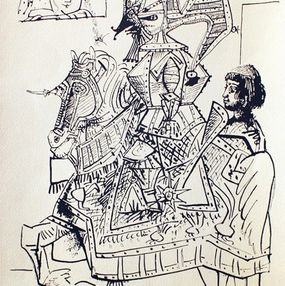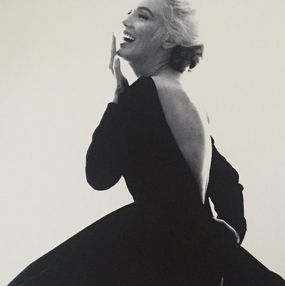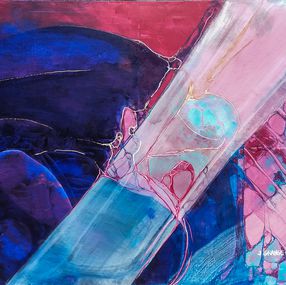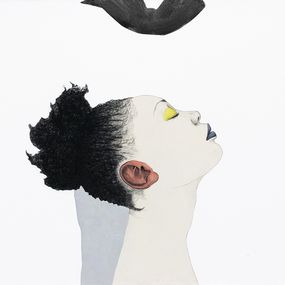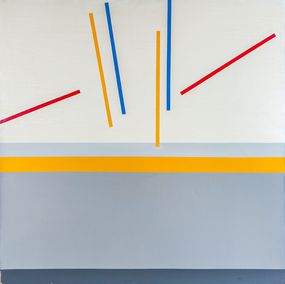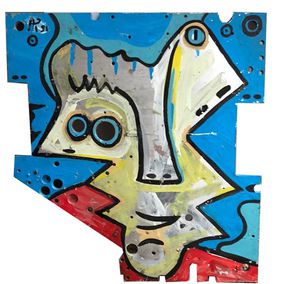
Portrait 3 (after Pablo Picasso),
1969
Pablo Picasso
Print : lithography
65.5 x 50.5 cm 25.8 x 19.9 inch
Free returns within 14 days
Authenticity guaranteed
Learn moreSecure payment
About the artwork
Type
Numbered and limited to 250 copies
Signature
Plate signed
Authenticity
Sold with certificate of Authenticity from the gallery
Invoice from the gallery
Medium
Dimensions cm • inch
65.5 x 50.5 cm 25.8 x 19.9 inch Height x Width x Depth
Support
Framing
Not framed
Tags
Artwork sold in perfect condition
Artwork location: France
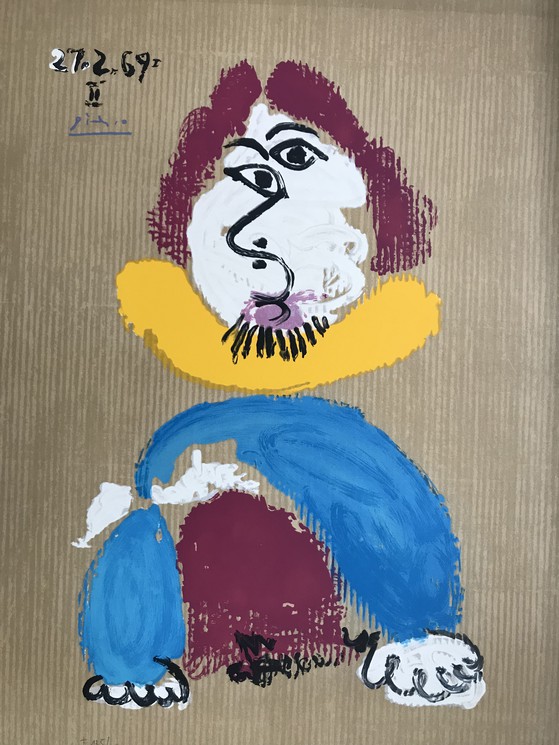
Discover more by the artist
Presentation
« To me there is no past or future in art. If a work of art cannot live always in the present it must not be considered at all », it is surely what guaranteed Pablo Picasso his universal and timeless recognition! Inspired by his passions of a given moment, and pushing the boundaries of art, he is considered among the most influential artists of the 20th century. His paintings, sculptures, prints and ceramics are absolutely key pieces in the museums of modern art of the world and have influenced some of the greatest artists. Born in 1881 in Malaga, Pablo Picasso was a real art prodigy. At the age of 8, he painted his first oil paintings, at 15 he entered Barcelona's art school, at only 19, he represented Spain the Exposition Universelle in Paris with « Last Moments ».
Following that, Picasso moved to Paris and discovered Toulouse-Lautrec, Degas, Gauguin and Cézanne. The suicide of his friend Casagemas, with whom he lived in Paris, had a profound effect on him and his sadness permeated all his canvases at the time, this was Picasso's « blue period ». From 1905, his melancholy and blue tones were replaced with joy and rose hues, when the painter fell in love with Fernande Olivier and moved to Bateau Lavoir, where he met artists and writers of the time: Matisse, Apollinaire, Jean Cocteau… this was his « rose period ».
From 1906, his obsession with a more complete representation of space inspired him, along with Georges Braque, to decompose objects and recreate them again on the canvas, in the manner of a collage, to show all facets of them. It was the emergence of Cubism that brought back into play the notion of perspective in art. His work « Les Demoiselles d'Avignon », breaking completely with all the codes of the era, sparked debate and would change, in an irreversible way, the rules for artistic creation in the 20th century.
Judging the image to be complicated to read, he abandoned Cubism in 1915 in favour of more traditional portraits, until the Spanish Civil War, when he painted his largest painting: « Guernica », depicting the horror of the Spanish Civil War and marking the beginning of his political engagement.
Picasso died in 1973 in Mougins, leaving behind me a life rich in amorous passions and moral commitments, permeating his work and marking the history of art indelibly. His work is omnipresent in all the largest modern art collections: at the Musée Picasso in Paris, at MoMA in New-York, in the Museo Reina Sofia and many others...
In 2024, the art world continued to celebrate the enduring legacy of Pablo Picasso, the renowned Spanish painter and sculptor. A notable exhibition, "Picasso and Paper", was held at the Cleveland Museum of Art, showcasing nearly 300 works that explored Picasso's innovative use of paper across various mediums, including collages and drawings. This exhibition offered a comprehensive look into Picasso's creative process and his experimentation with materials.
Looking ahead, 2025 promises significant events honoring Picasso's artistic contributions. From February 14 to June 29, 2025, the Atelier des Lumières in Paris will host an immersive exhibition titled "Picasso, Art in Motion". This exhibition aims to delve into Picasso's eclectic and abundant universe, highlighting his relentless energy and constant reinvention of art through a collection of his works, photographs, and videos. Visitors can expect to experience a dynamic journey through various phases of Picasso's career, from his early works to his later masterpieces.
Cubism
Magic Realism
Sculptors
Photographers
Printmakers
Designers
Spanish artists
More works from Galerie vingt sur vingt
Artsper delivers internationally. The list of countries is available in the first step of your cart.
If your country is not listed contact us at [email protected] and we will see what we can do.
Note that Customs fees may apply for works shipped internationally. This is indicated in the first step of the shopping cart.
You can choose a delivery address different from the billing address. Make sure that a trusted person is present to receive the work if you cannot be there.
Have you purchased a painting, sculpture or work on paper?
Find our expert advice for the conservation and promotion of your works in the articles below:
Artsper offers you access to more than 200,000 works of contemporary art from 2,000 partner galleries. Our team of experts carefully selects galleries to guarantee the quality and originality of the works.
You benefit from:
-
Works at gallery price
-
Return within 14 days, regardless of your location
-
Easy resale of the work purchased on Artsper
-
Personalized research tools (selection and tailor-made universe)
Our customer service is available for any assistance.
At Artsper, our mission is to allow you to collect works of art with complete peace of mind. Discover the protections we offer at every stage of your shopping experience.
Buy works from top galleries
We work in close collaboration with carefully selected art galleries. Each seller on Artsper is carefully examined and approved by our team, thus ensuring compliance with our code of ethics. You therefore have the assurance of purchasing authentic, high-quality works.
Total transparency: you know what you are buying
Before being posted online, all artwork on Artsper is reviewed and validated by our moderation team. You can browse with complete peace of mind, knowing that each piece meets our criteria of excellence.
Personalized support: our experts at your service
Our team of contemporary art experts is available by phone or email to answer all your questions. Whether you want advice on a work or a tailor-made selection to enrich your collection, we are here to support you.
Resell your works with ease
If you have purchased a work on Artsper and wish to resell it, we offer you a dedicated platform to relist it. To find out more, click here.
Make offers with Artsper: negotiate like in a gallery
You have the possibility to propose a price for certain works, just like in a gallery. This feature allows you to initiate discussions and potentially acquire your coins at advantageous prices.
Get help with your negotiations
Our team will negotiate for you and inform you as soon as the best offer is obtained. Do not hesitate to call on our expertise to ensure a transaction at the best price.
Order securely
Artsper satisfaction assurance
We want you to be completely satisfied with your purchase. If the work you receive is not to your liking, you have 14 days to return it free of charge, and you will be refunded in full, whatever the reason.
Secure payment with Artsper partners
All credit card payments are processed by Paybox, the world leader in payment solutions. Thanks to their strict security standards, you can transact with confidence.
Problem Support
In the rare event that an artwork arrives damaged or not as described, we are here to help. Whether for a return, refund, restoration or exchange, our team will support you throughout the process and will ensure that we find the solution best suited to your situation.
Conditions to benefit from Artsper protections:
-
Use one of the payment methods available on Artsper for your order.
-
Report any problems within one week of receiving the work.
-
Provide required photographic evidence (including original artwork and packaging).
Artsper guarantees cover the following cases:
-
The received work lacks a described characteristic (for example, a signature or frame).
-
The artwork has significant differences from its description (e.g. color variation).
-
The work is damaged upon receipt.
-
The work is lost or damaged by the carrier.
-
Delivery is significantly delayed.
With Artsper, you collect with complete peace of mind.
